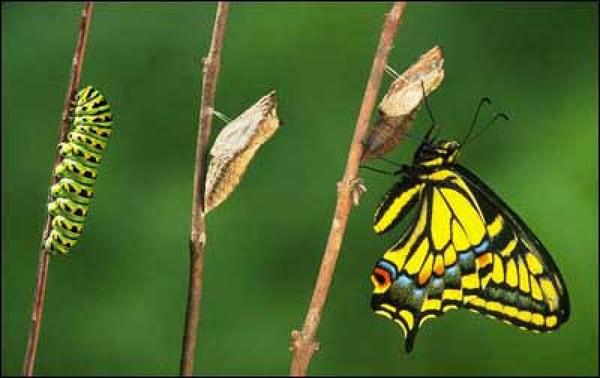The weird and wonderful metamorphosis of the butterfly

In order to become a butterfly, a caterpillar’s body dissolves almost completely and is rebuilt from its own juices. As inconvenient and even downright dangerous as this process sounds, it’s actually quite common. Butterflies are just a few of the 800,000 insect species that transition from larvae to adults through complete metamorphosis. That’s approximately 85% of insects and 70% of all known animal species. But how exactly does a caterpillar become a butterfly? When a caterpillar hatches from an egg, it has none of a butterfly’s physical traits. It does have groups of cells inside its body called imaginal discs that will eventually become its butterfly parts. For now, these cells remain dormant. Juvenile hormone suppresses their activity, and prevents the caterpillar from beginning metamorphosis too early. Immediately after hatching, the caterpillar begins to feed, building up fat until its rigid skin, called a cuticle, becomes too tight. At this point, a hormone called ecdysone triggers the cuticle to shed, or molt. As the caterpillar grows, it usually molts four times. Then, when it’s nice and plump, the caterpillar’s levels of juvenile hormone drop, which triggers it to stop eating and moving. A final burst of ecdysone prompts the caterpillar’s cells to begin to self-destruct. Soon, the muscles, fat, and other tissues are almost entirely liquefied, though the imaginal discs stay intact and begin to grow. At the same time, a second skin layer called the pupal cuticle forms underneath the first. One more molt exposes the hard exterior of the pupa. Besides the imaginal discs, only a few tissues are spared, including parts of the respiratory system, the heart, some abdominal muscles, and the mushroom bodies of the brain. The caterpillar juice then fuels the development of the imaginal discs into eyes, antennae, legs, wings, genitalia, and other body parts. Once its new body is built, the insect molts one last time, shedding the pupal cuticle. From there, it’s free to fly away a new butterfly. Even after such a dramatic transformation, the butterfly does retain some memories from its caterpillar days. It’s likely the mushroom bodies of the brain carry important knowledge from the caterpillar over to the adult butterfly. How did such an involved developmental process come to be? We don’t know for sure. The leading theory is that the caterpillar is actually a drawn-out version of a life stage that takes place inside the egg for some other insects. According to this hypothesis, over millions of years, the larvae evolved the ability to eat and live outside the egg. Regardless of how complete metamorphosis originated, it’s become part of the life cycles of a dizzying number of insect species. Still, plenty of species get along perfectly well with a simpler developmental process. What survival advantages might complete metamorphosis provide to make up for the added hassle? For one, it keeps larvae and adults from competing for the same habitats and food sources. And while the pupa may seem vulnerable, this immobile stage can actually be a good way to pass parts of the year when food is scarce. To us, a butterfly’s metamorphosis might sound as fantastic as a phoenix rising from its ashes. But these transformations are taking place all around us, all the time. From the Hercules beetle to the honey bee to the garden ant, countless squishy larvae dissolve and emerge as armored, aerodynamic, and nimble adults.